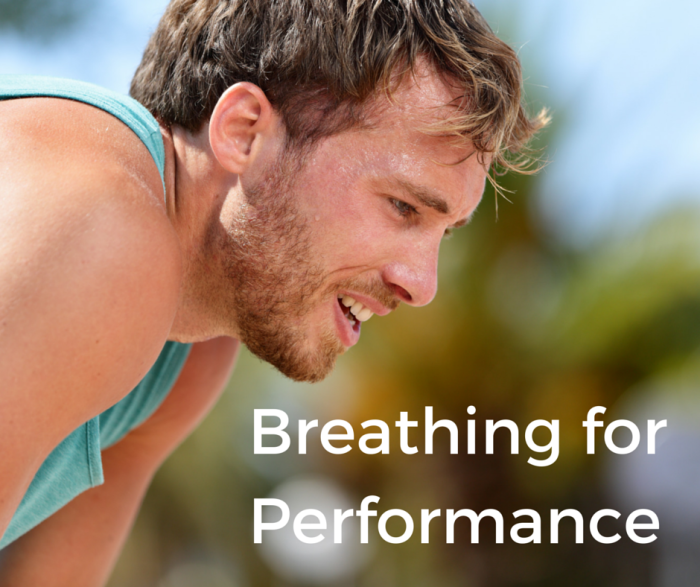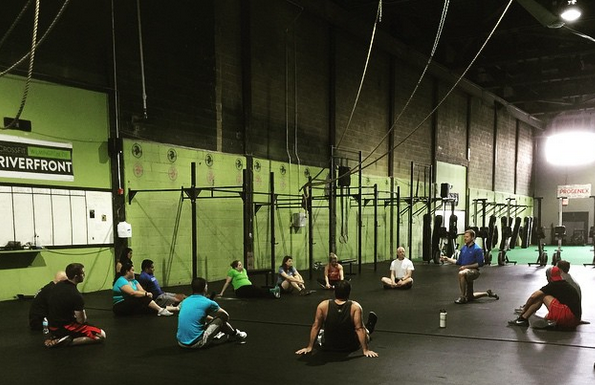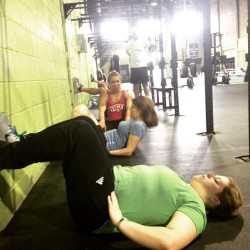Breathing for Performance
Posted May 26, 2015
Hit a PR plateau? Getting gassed early on in a running WOD?
Have you taken a good look at your breathing?
Most of us don’t breathe as deeply as we could— or we should. Take a breath in: if you find your chest rising, but your stomach isn’t, you’re not engaging your diaphragm or using your lungs to their fullest potential. (Compare that to the breathing of a young child, and you’ll see that both their chest and belly rise and fall as they breathe in and out.)
Shallow breathing can affect heart rate, increase stress and weaken your core over time, cumulatively affecting performance during a WOD.
How do you know if bad habits— poor posture, subconsciously sucking your stomach in— have affected your breathing, and what can you do to improve your breathing technique?

We recently welcomed Physical Therapist and Certified Strength & Conditioning Specialist Jon Herting, DPT, CSFS, HFS, USAW from The Training Room for a short seminar on breathing for performance. In one short hour, he had us work through some exercises that provide breath biofeedback, and provided us with plenty to think about and work on when it comes to optimizing our breathing.
Here are some takeaways:
The majority of us have poor posture, especially when we sit at a computer all day. When we do think about posture, we tend to overcompensate. Keep your ears over your shoulders.
Due to the stress of our everyday schedules, we spend a lot of time in “fight or flight”— triggered by the sympathetic nervous system. The additional stress of a tough WOD really gets that fight or flight response jumping into the red zone. Working on breathing techniques outside the box and implementing them during a workout can help pull us back into the “rest and digest” zone— powered by the parasymapthetic nervous system— more quickly. (When I played basketball, we were told to close our eyes, lace our fingers together and put our hands on our head when we had a moment to rest. This opened up the chest and diaphragm and helped bring our heart rate back down.)
When you breathe, you should be thinking about filling your core like a cylinder; 360 degrees around. This maximizes the amount of oxygen you’re taking in— important, high quality air transfer happens in that last third of your lungs— and engages and trains your diaphragm for a stronger core.
If you’ve hit a plateau and suspect your breathing technique could use some improvement, let your ego go a bit and step down in weights while you work on your breathing. Once your breathing game is on point you can start building up again. Your stronger core will help you bust through that plateau!
During a workout, try to breathe in and out through your nose, ideally for a three count in, nine count out. More efficient oxygen transfer means you don’t have to work as hard for each breath, conserving energy for your other muscles. Also, concentrating on your breathing during a tough chipper can have a calming effect, helping to lower your heart rate and keep you focused. Aim to stay in the parasympathetic zone as long as possible so you don’t burn out as quickly (physically or mentally).
Checked out the fitspo on Instagram lately? Most of us know that to get a sweet six pack takes a lot of work and equal dedication in the kitchen. What you might not know is that really defined ab muscles beyond the traditional washboard could be a sign of dysfunction, due to the way the muscles are being engaged from your breathing.
There are different breathing techniques for different applications: the optimal breathing strategy for a sprinter won’t be the same as one for a long distance runner.

For biofeedback on our own breathing, we tried the following exercises:
- Lying down on your back, place feet on a wall so that your thighs are at a 90 degree angle with the floor. Have a partner place their fingertips on your stomach and try to breathe so that your diaphragm rises to meet their fingers. Repeat with their fingertips at your lower back, and on your sides.
- Child’s pose (kneel; lower so forehead touches floor; drop arms by your sides so fingertips are by your heels). Feel your breath make contact with your legs.
- Lie facedown with your face resting on your hands; feel your breathe press your belly against the floor.
Practicing proper breathing at home will not only make your respiratory system more efficient, increase stamina and strengthen your core; it can reduce tension, re-energize you, and help you to think more clearly. Try it out and tell us how it goes.
Have breathing questions? Want Jon Herting to come back for another seminar? Let us know!
For more info about The Training Room, check out http://www.thetrainingroompt.com/ or follow on Facebook and Twitter.
Tags: breathing exercises for workouts, proper breathing techniques
Categorised in: Blog
Comments are closed here.